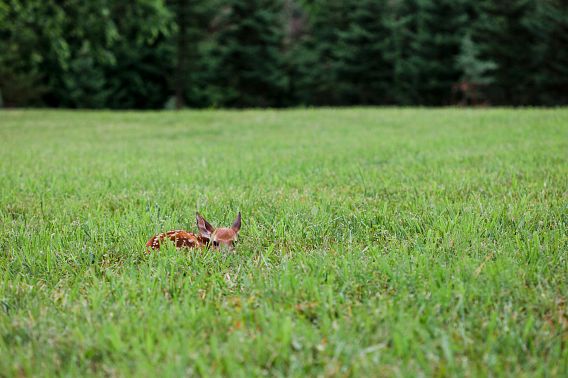Contact: Jenna Fastner, DNR Captive Wildlife Health Specialist
Jenna.Fastner@wisconsin.gov or 715-894-7181
Keep Wildlife Wild: Know What To Do If You Find A Fawn
 If you find a fawn lying still and quiet, leave it alone. Leave the area and do not go near the spot again.
Photo credit: Cavan Images
If you find a fawn lying still and quiet, leave it alone. Leave the area and do not go near the spot again.
Photo credit: Cavan Images
MADISON, Wis. – Spring is baby animal season in Wisconsin, and the Wisconsin Department of Natural Resources (DNR) reminds the public to leave fawns alone while they’re out exploring the state during the warm weather months. If you encounter a fawn while outdoors, the DNR urges you not to touch it or intervene in any way – there’s a good chance it’s right where it’s supposed to be and its mother isn’t far away.
In the first few weeks of life, fawns are left alone most of the day and stay hidden while their mothers stay some distance away to avoid drawing attention to their fawns’ location. They lie still in brush or grass, keeping quiet until their mothers return. Although the mother can return at any time of day to nurse the fawn, white-tailed deer are crepuscular or more active at dawn and dusk, which means the fawn can be alone for long periods between feedings.
“Fawns have specialized dietary needs that are not easily met, and they need to learn normal social behaviors from their mothers. Keeping your distance and not intervening gives the fawn its best chance for survival,” said Jenna Fastner, DNR Captive Wildlife Health Specialist.
It is rare that an unaccompanied fawn has been abandoned. If you find a fawn lying still and quiet, leave it alone. Leave the area and do not go near the spot again. Do not touch the fawn or bring children, pets or friends to look at it. Doing so could endanger the fawn by giving away its location to a predator, and its mother won't return to nurse the fawn while people or pets are nearby.
“Fawns can walk from birth but need a few weeks to grow fast enough to keep up with their mothers and avoid predators. By the Fourth of July, most fawns are on the move alongside or nearby their mothers because they have the speed and agility to run from danger,” said Fastner. “Until they reach that point, their spotted coats and minimal scent are their best defenses from predators.”
If you have further questions or encounter a fawn that appears sick or injured, call the DNR or a licensed wildlife rehabilitator for guidance. Please note it is against the law in Wisconsin to possess a wild animal without the proper license.
For more information on what to do if you find a fawn or any other baby animal, visit the DNR’s website.

